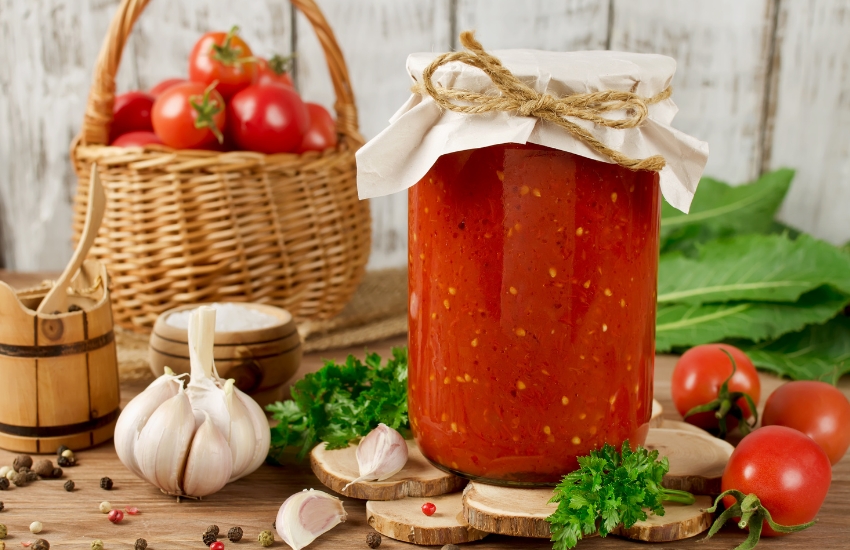Canning tomatoes is a fantastic way to preserve their freshness and flavor, ensuring you can enjoy their taste all year round. Whether you’re a seasoned canner or a beginner, this guide will walk you through the step-by-step process of canning tomatoes. From selecting the best tomatoes to storing the finished product, we’ve got you covered.
If your garden yields an abundance of tomatoes or you come across a great deal of locally grown, sun-kissed tomatoes, canning them is a beautiful way to preserve summer flavors. This beginner’s guide to canning tomatoes will walk you through the step-by-step process and address any questions about canning.
Two primary methods for canning tomatoes are a boiling water bath or a pressure canner. It’s important to note that a pressure canner is distinct from a pressure cooker, which is unsuitable for canning. Pressure canners are equipped with either a dial gauge or a weighted gauge and a rack for holding the jars. They are typically larger than pressure cookers and can accommodate at least one layer of quart jars.
If you don’t have access to a pressure canner, don’t worry! It is still possible to can tomatoes using the water bath method if you follow the instructions carefully. Additionally, you don’t necessarily need a specialized water bath canner; any sufficiently large pot covering the jars with at least an inch of water will suffice.
Regardless of the canning method you choose, acidification is crucial to ensure the safety of canned tomatoes. If this process seems too involved for you, an alternative option is to freeze the tomatoes instead.
The following instructions outline how to can whole or halved tomatoes using the hot-pack method, where the tomatoes are briefly cooked before being released in water. It’s worth noting that you can also raw-pack tomatoes; however, hot-packing offers two significant advantages: it allows you to fit more tomatoes in each jar, minimizing the number of pots that need processing, and cooked tomatoes are less prone to floating on top after processing due to reduced air content.
Equipment for Canning Tomatoes
To get started, you will need some essential equipment. Here’s what you’ll need for approximately 22 pounds of tomatoes:
- Six to seven quart-size mason jars with screw rings and new, unused lids
- A boiling-water canner or a huge stock pot with a rack or kitchen towel at the bottom to prevent the jars from resting directly on it
- A ladle
- A wide-mouth funnel
- Jar tongs (sometimes called jar lifters)
- A couple of cooling racks
- A few clean kitchen towels
- An added acid, such as bottled lemon juice
Do Tomatoes Need to Be Canned with Added Acid?
Tomatoes have relatively low acidity, meaning they must be acidified for safe canning. Since foods with a pH higher than 4.6 can harbor botulism bacteria spores, it is essential to raise the acid level of tomatoes. Tomatoes typically have a pH of around 4.5, so the USDA increases the. Additionally, if you add ingredients like onions, garlic, or basil, the acidity level will be further reduced.
Bottled lemon is the recommended ingredient to increase the acidity. Add 1 tablespoon of bottled lemon juice to each pint jar or tablespoons to each quart jar. Why bottled lemon juice? Fresh lemon can vary in acidity, making it less reliable for canning. Alternatively, citric acid can be used (1/2 teaspoon per quart or 1/4 teaspoon per pint), but it may impart a more pronounced flavor than lemon juice.
How to Can Tomatoes
Canning requires a series of steps that should be completed on time and must be completed from start to finish. It is recommended to allocate a whole morning or afternoon for the process and ensure you have all the necessary equipment before you begin. The method outlined below is specifically for crushed hot-packed tomatoes and involves the following steps:
Choosing the Right Tomatoes
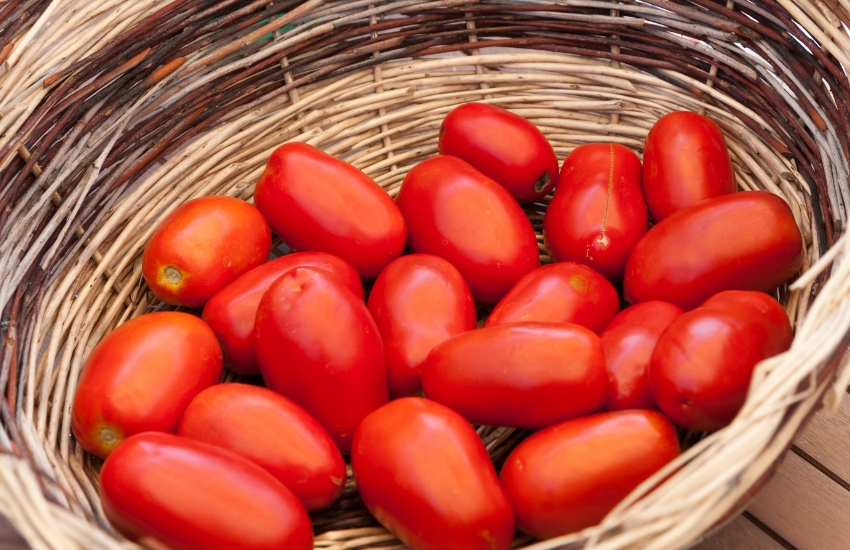
Before you start the canning process, selecting the correct type of tomatoes is crucial. Choose tomatoes that are fully ripe, firm, and free from blemishes. Varieties like Roma, plum, or San Marzano work well due to their meaty texture and rich flavor. However, the most crucial factor is to use ripe tomatoes. Discarding any bruised or overripe fruit and extremely under-ripe fruit is essential, as their quality will not improve through the canning process.
Step 1: Sterilize Jars and Equipment
- Start by sterilizing your tools. Wash your jars, lids, rings, funnel, spoon, and jar tongs in soapy water and rinse them thoroughly.
- Sterilize the jars by placing them in a boiling-water canner. Cover them with hot water and bring them to a simmer. Adjust the heat and let them simmer for 10 minutes. Keep the jars in the hot water until you’re ready to fill them. If you have many pots, run them through the dishwasher (if it sterilizes) and keep them in a 220 degrees Fahrenheit oven until ready to use them. It’s essential to keep everything hot until just before you start canning.
- Sterilize the lids by placing them in a bowl along with the screwtops. Pour boiling water over them and leave them in the water until needed. Using a lid caddy can help keep everything organized.
Step 2: Prepare the Canning Device
For water bath canning:
- Use a water bath canner or place a silicone trivet or rack in a large pot or stockpot to prevent the jars from sitting directly on the bottom.
- Place the jars in the canner or pot, ensuring they are stable and not touching each other.
- Fill the canner or pot with enough water to submerge the jars fully.
For pressure canning:
- Add 2 inches of water to the pressure canner.
- Carefully place the jars in the water, ensuring they are upright and not touching each other.
- Fill the jars with water to the appropriate level as recommended for your specific recipe or guidelines.
Step 3: Bring Water to a Simmer
Slowly bring the water in the canning device to a simmer while you prepare the tomatoes.
Step 4: Wash and Cut Tomatoes
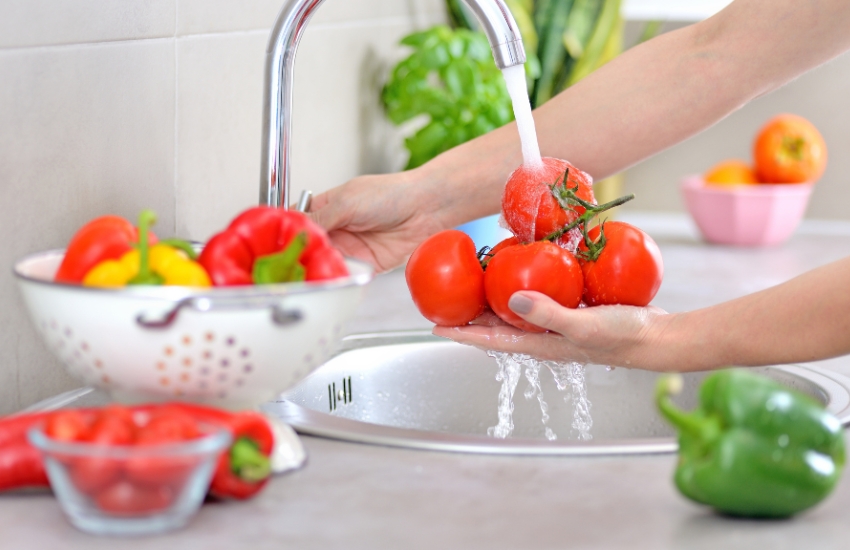
Start by washing the tomatoes and removing the stems.
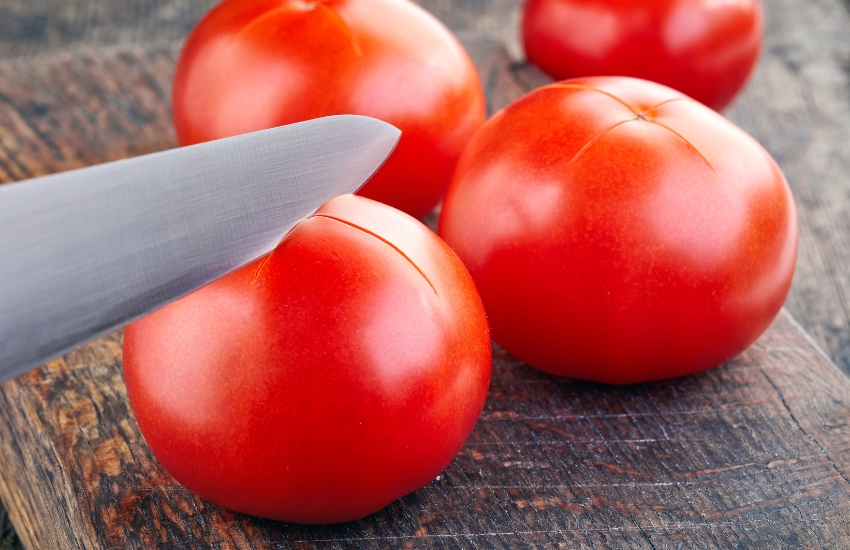
Using a paring knife, make a shallow X-shaped cut on the bottom of each tomato.
Step 5: Blanch the Tomatoes
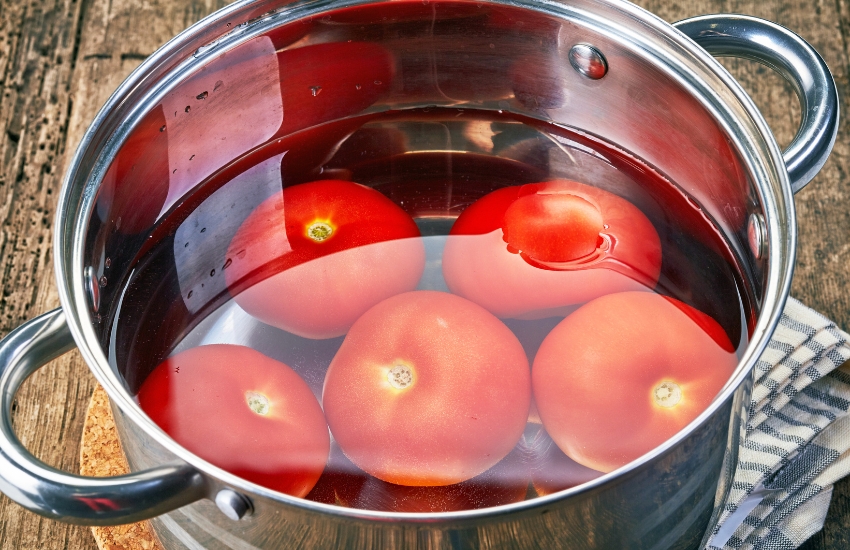
Bring a large pot of water to a boil. Blanch a few tomatoes at a time in the boiling water, just enough for the skin to start curling up where you cut. The blanching time will vary, but it usually takes around 30 seconds, depending on the size of the tomatoes.
Step 6: Dip the Tomatoes in Ice Water
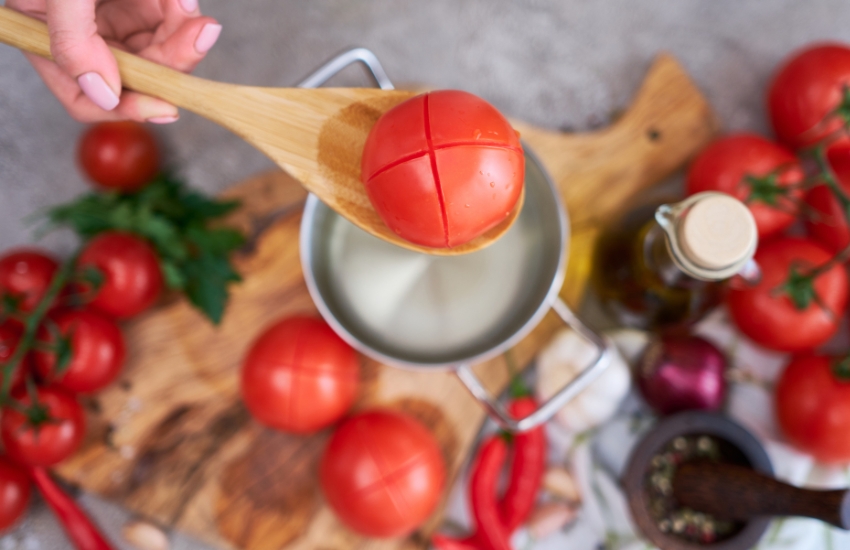
Carefully transfer the blanched tomatoes to a bowl filled with ice water using a slotted spoon. Allow them to cool for a few minutes. Then, place the tomatoes in a colander set over a bowl to drain any excess liquid.
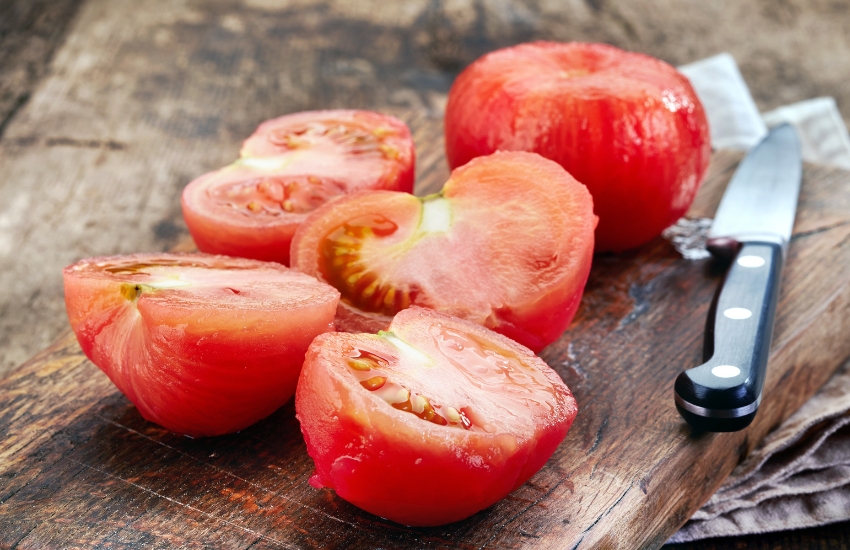
Remove the skins and cores once the tomatoes are cool enough to handle. For larger tomatoes, you may need to cut them in half.
Step 7: Cook the Tomatoes
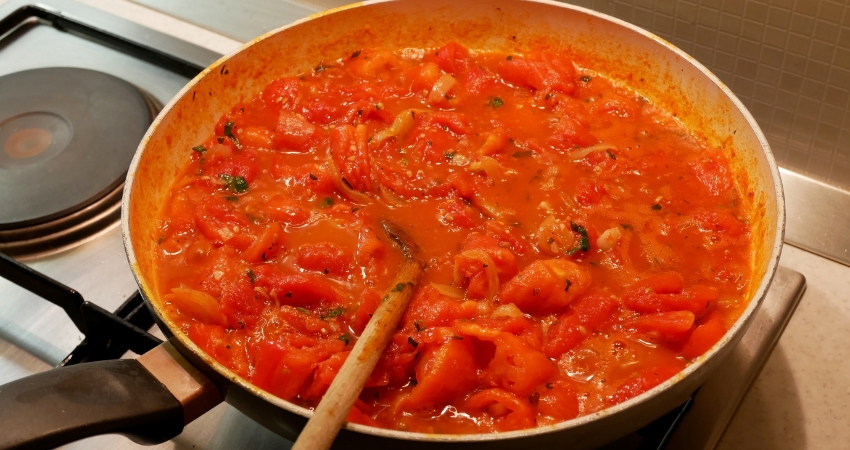
Return the blanched tomatoes and any remaining liquid to the pot. Cover them with water and bring them to a boil. Reduce the heat to medium-low and let the tomatoes cook for 5 minutes.
Step 8: Remove the Jars
Using the jar lifter tongs, carefully remove the jars from the water bath canner/pot or pressure canner. Empty any water that may be inside the jars. Keep the water in the canner/pot simmering. Place the empty jars on a damp tea towel to prevent cracking when filling them with hot tomatoes.
Step 9: Add Bottled Lemon Juice or Citric Acid
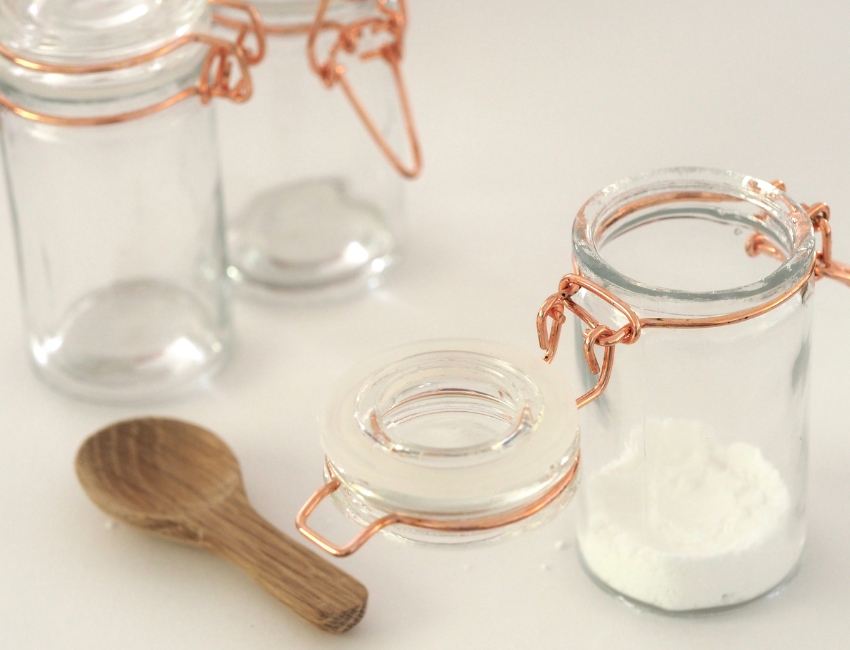
Add 1 tablespoon of bottled lemon juice or 1/4 teaspoon of citric acid to each pint jar. Add 2 tablespoons of bottled lemon juice or 1/2 teaspoon of citric acid for quart jars.
Step 10: Fill the Jars With Tomato Mixture
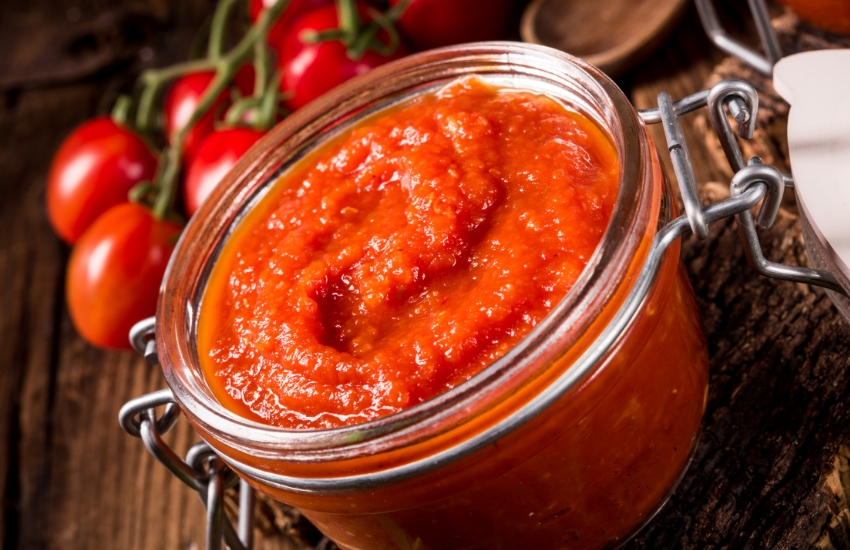
Fill the jars with the hot cooked tomatoes, leaving 1/2-inch headspace at the top. Press down on the tomatoes to pack them tightly and remove any air pockets. Ensure the tomatoes are fully immersed in liquid, adding more cooking liquid if necessary.
Step 11: Wipe the Rims of the Jars
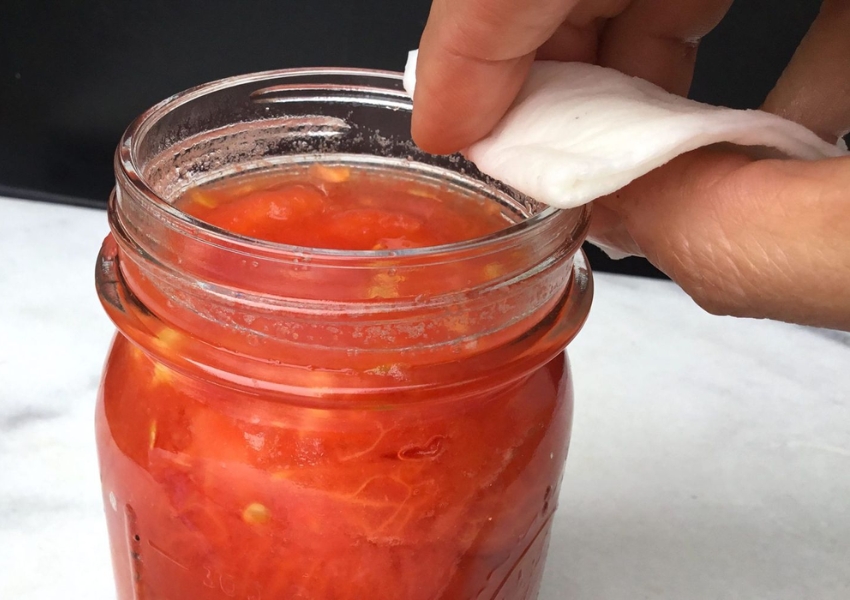
Using a damp paper towel, carefully wipe the rims of the jars to remove any spills or residue. This will help ensure a proper seal.
Step 12: Seal the Jars
Place new lids and bands on the jars, tightening them securely but not overly tight.
Step 13: Process the Jars
Place the filled jars back into the canner/pot for water bath canning, ensuring they are covered with at least 1 inch of water. Add more water if needed. Process pint jars for 40 minutes and quart jars for 45 minutes, maintaining a steady gentle boil. Adjust processing time if you are at an altitude above 1,000 feet.
Follow the manufacturer’s instructions for venting and processing times for pressure canning based on your specific pressure canner. Process pint and quart jars at 11 pounds pressure for 10 minutes in a dial-gauge pressure canner. Process pint and quart jars at 10 pounds pressure for 10 minutes in a weighted-gauge pressure canner.
Step 14: Remove the Jars
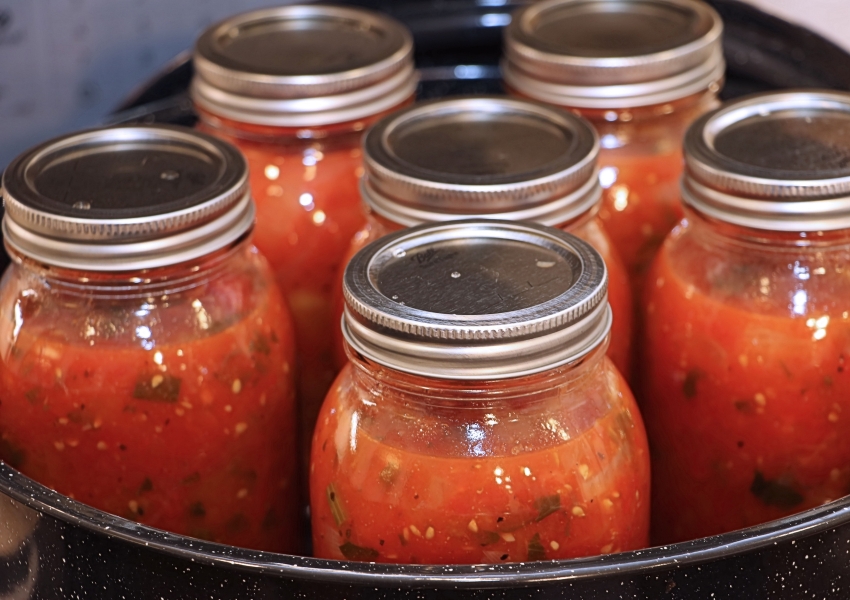
After processing, if using a water bath canner, turn off the heat and let the jars sit in hot water for 5 minutes to prevent siphoning (liquid bubbling out). Carefully remove the jars with the jar lifter onto a damp tea towel. Allow them to cool and settle undisturbed for 24 hours.
If using a pressure canner, wait for it to depressurize before opening fully. Remove the jars and let them cool and settle undisturbed for 24 hours. Check the seal and remove the bands before storing the pots.
How to Can Crushed Tomatoes
To prepare crushed tomatoes for future recipes like pizza sauce, chili, or soup, follow these steps:
- Wash and peel the tomatoes.
- Cut the tomatoes into quarters and add enough to cover the bottom of a large pan.
- Crush the tomatoes using a wooden spoon and heat the mixture until it boils while stirring.
- Slowly add the remaining tomato pieces, stirring constantly, and let it simmer for 5 minutes.
- Fill the jars, leaving a ½-inch headspace, and add bottled lemon juice and salt. Add 1 tablespoon of lemon juice and ¼ to ½ teaspoon of salt for pints. Add 2 tablespoons of lemon juice and ½ to 1 teaspoon of salt for quarts.
- In a boiling-water canner, process the pints for 35 minutes and the quarts for 45 minutes.
How to Can Tomatoes with No Added Liquid
If you prefer not to add extra liquid when canning tomatoes, you can follow these steps:
- Wash and peel the tomatoes and halve them if desired.
- Fill the jars, pressing the tomatoes to fill any spaces with juice.
- Add bottled lemon juice and salt. Add 1 tablespoon of lemon juice and ¼ to ½ teaspoon of salt for pints. Add 2 tablespoons of lemon juice and ½ to 1 teaspoon of salt for quarts. Leave a ½-inch headspace.
- In boiling water, process pints and quarts for 85 minutes.
How to Can Stewed Tomatoes
If you want to make and can stew tomatoes as a base for future recipes like pasta sauce or soup, here’s what you need to do:
- Start with 8 pounds of ripe tomatoes. Wash them and remove the peels, stem ends, and cores. Chop the tomatoes and measure approximately 17 cups.
- Place the chopped tomatoes in an 8- to 10-quart Dutch oven or kettle. Add 1 cup of chopped celery, ½ cup of chopped onion, ½ cup of chopped green bell pepper, 2 teaspoons of sugar, and 2 teaspoons of salt.
- Bring the mixture to a boil, then reduce the heat. Cover and simmer for 10 minutes, stirring frequently to prevent sticking.
- Ladle the hot stewed tomatoes into hot and clean quart or pint canning jars, leaving 1-inch headspace. Wipe the jar rims and adjust the lids.
- Process the jars in a pressure canner at 10 pounds pressure for 20 minutes for quarts or 15 minutes for pints.
- Allow the pressure to come down naturally. Remove the jars from the canner and let them cool on racks.
Pressure-Canning Tomatoes
If you have a pressure canner instead of a boiling-water canner, you can use it to pressure-can tomatoes. The process is similar, starting with sterilizing jars, lids, and bands and peeling the tomatoes. Fill each jar following the instructions for canning tomatoes with no added liquid.
Even with a pressure canner, acidifying your tomatoes for preservation is essential, so remember to add lemon juice. Once the jars are filled, follow these processing instructions:
- For a weighted-gauge pressure canner, process pints, and quarts for 40 minutes at 5 pounds of canner gauge pressure (PSI) if you’re less than 1,000 feet above sea level. If you’re over 1,000 feet above sea level, process for 40 minutes at 10 pounds PSI.
- For a dial-gauge pressure canner, process pints, and quarts for 40 minutes at 6 pounds PSI if you’re less than 2,000 feet above sea level. If you’re between 2,001 and 4,000 feet, use 7 pounds PSI; between 4,001 and 6,000 feet, use 8 pounds PSI; and between 6,001 and 8,000 feet, use 9 pounds PSI.
Conclusion
Canning tomatoes is a delightful and rewarding endeavor that allows you to capture the essence of summer’s bounty. Following the detailed steps in this guide, you can create jars of preserved tomatoes that bring a burst of flavor to your meals all year round. So gather your supplies, choose the finest tomatoes, and embark on a canning adventure that promises to enhance your culinary creations.
FAQs about Canning Tomatoes
Do you need to cook tomatoes before canning?
To can the tomatoes, you will place them raw into the jars. Afterward, you can process the jars using a water bath or a pressure canner. If you prefer a hot packing method, consider canning tomato sauce instead, as cooking the tomatoes beforehand will result in a saucy consistency.
What is the difference between a tomato and a canning tomato?
Although canned tomatoes are appreciated for their deep and robust flavor, it’s important to note that they may lose some of the health benefits typically associated with fresh tomatoes. This is primarily due to additives like salt and sugars sometimes present in canned tomatoes, resulting in higher calorie, carbohydrate, and sodium content than fresh tomatoes.
Do you need lemon to can tomatoes?
By adding citric acid, bottled lemon juice, or vinegar in the correct amounts, you can ensure that when canning tomatoes using either the boiling water bath or pressure canning method, the C. botulinum spores cannot germinate. It is essential to follow a trusted recipe and ensure the jars are processed correctly to maintain safety and prevent potential issues.
How long do you boil tomatoes for canning?
To process tomatoes, boil them for 85 minutes at sea level. For every 1,000 feet above sea level, add 5 minutes to the processing time. Once the designated processing time is complete, carefully remove the jars from the canning apparatus.
What are 2 methods of preserving tomatoes?
Tomatoes can be preserved through various methods, such as canning, drying, freezing, or pickling. Additionally, they can be utilized in making fruit spreads like jams, jellies, and marmalades. While raw tomatoes or raw tomato products can be stored in the refrigerator (below 40 degrees Fahrenheit), it’s important to note that they will eventually spoil due to bacteria, yeasts, and molds.
Do you add sugar when canning tomatoes?
When pressure canning or boiling water bathing tomatoes, it is necessary to acidify them. To do this:
- Add acid directly to the jars before filling them with tomatoes.
- Add up to 1 tablespoon of sugar per quart to balance the acidic taste.
What are the safe methods for canning tomatoes?
Tomatoes can be processed safely using boiling water, steam, or pressure canner. While the traditional boiling-water canner and pressure canner methods have been widely used, the atmospheric steam canner is a newer option for home canning. One advantage of the steam canner is that it requires only 2 quarts of water, significantly less than the 16 quarts or more needed for a boiling-water canner. With less water to heat, the processing time can start more quickly.

